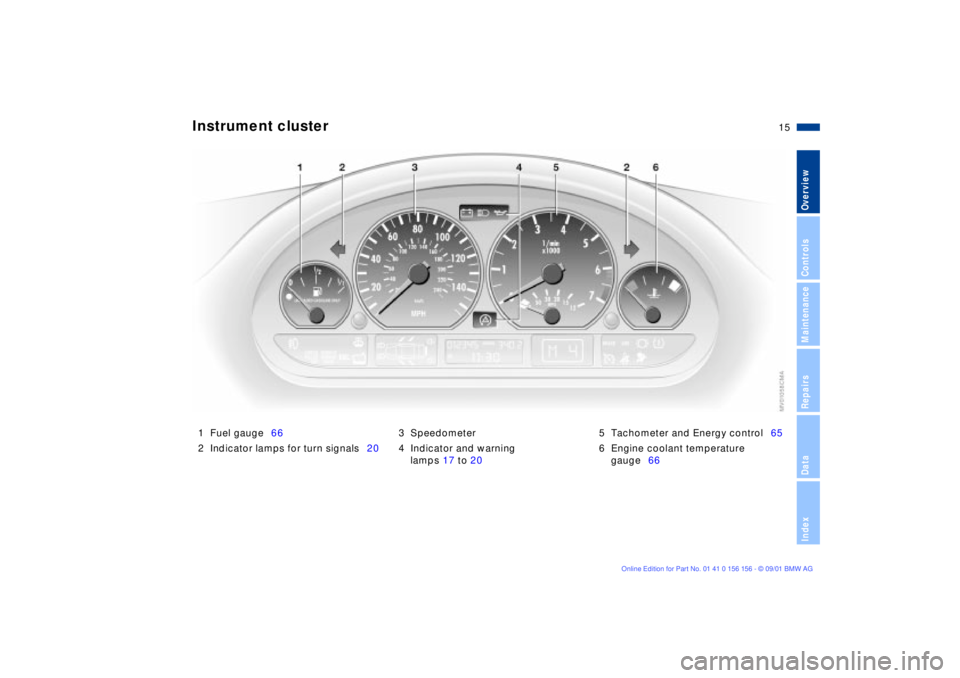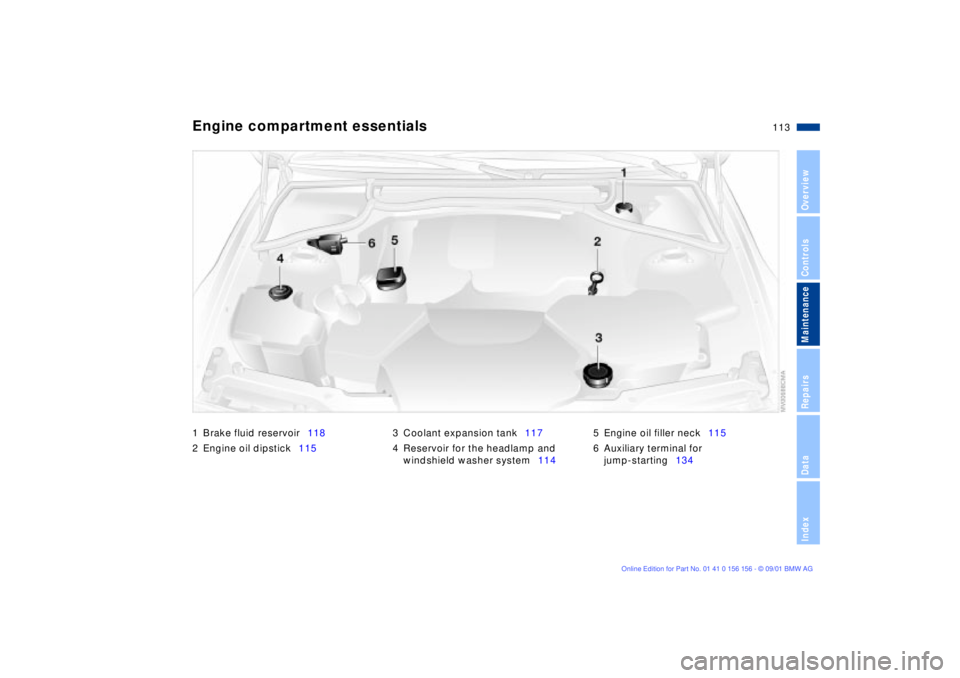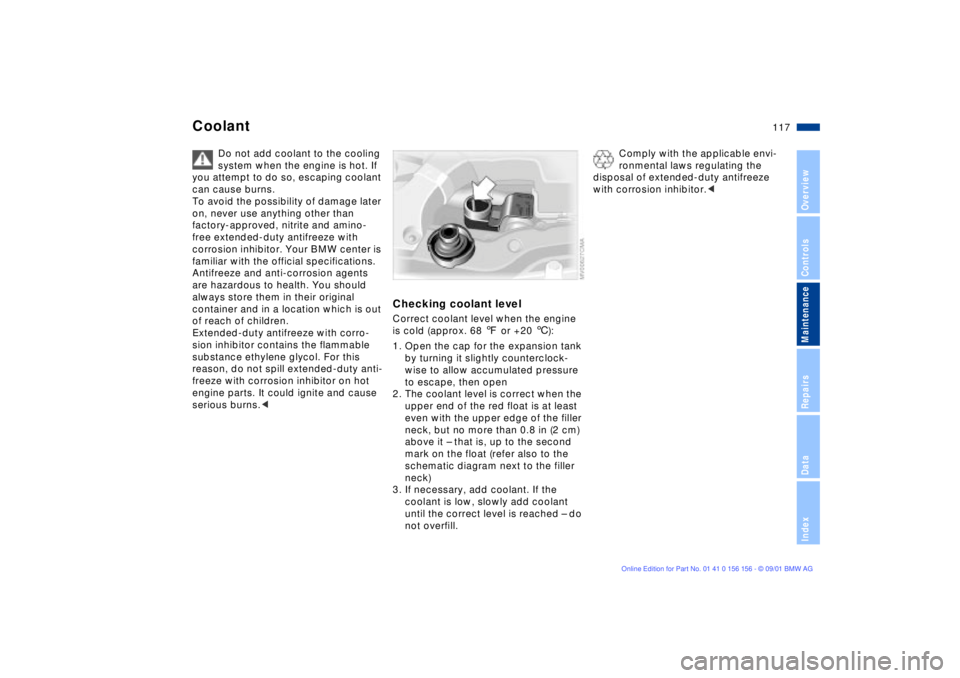2002 BMW 325I WAGON coolant
[x] Cancel search: coolantPage 4 of 155

Contents
© 2001 Bayerische Motoren Werke
Aktiengesellschaft
Munich, Germany
Reprinting, including excerpts, only with the
written consent of BMW AG, Munich.
Order No. 01 41 0 156 156
US English VIII/01
Printed in Germany
Printed on environmentally friendly paper
(bleached without chlorine, suitable for recycling).
Overview
Controls and features
Cockpit14
Instrument cluster15
Indicator and warning lamps17
Multifunction steering wheel
(MFL)21
Hazard warning triangle22
Refueling22
Fuel specifications23
Tire inflation pressures24
Opening and closing:
Keys28
Central locking system28
Opening and closing Ð via the
remote control29
Opening and closing Ð via the
door lock31
Opening and closing Ð from the
inside32
Tailgate33
Rear window34
Cargo area35
Alarm system35
Electric power windows37
Sliding/tilt sunroof38
Adjustments:
Correct sitting posture40
Seats40
Manual seat adjustment41
Power seat adjustment42
Lumbar support42
Head restraints43
Safety belts44
Seat and mirror memory45
Seat heating46
Steering wheel46
Mirrors47
Passenger safety systems:
Airbags48
Transporting children safely51Vehicle Memory, Key
Memory54
Driving:
Ignition lock55
Starting the engine55
Switching off the engine56
Parking brake57
Manual transmission57
Automatic transmission with
Steptronic58
Indicator/Headlamp flasher60
Washer/Wiper system/Rain
sensor61
Cruise control63
Everything under control:
Odometer65
Tachometer65
Energy control65
Fuel gauge66
Coolant temperature gauge66
Service Interval Display66
Check Control67
Clock67
Computer68
Technology for safety and
driving convenience:
Park Distance Control (PDC)70
Automatic Stability Control plus
Traction (ASC+T)71
Dynamic Stability Control
(DSC)73
Contents
Page 5 of 155

5n
OverviewControlsMaintenanceRepairsDataIndex
Controls and features
Operation, maintenance
Hill Descent Control (HDC) 77
Tire Pressure Monitor (RDC)78
Flat Tire Monitor80
Lamps:
Parking lamps/Low beams82
Instrument lighting83
High beams/Standing lamps83
Fog lamps83
Interior lamps84
Controlling the climate for
pleasant driving:
Air conditioning85
Automatic climate control88
Interior conveniences:
Sound system91
Glove compartment92
Storage compartments92
Cellular phone94
Ashtray, front94
Ashtray, rear95
Electrical power socket95
Loading and transporting:
Ski bag96
Cargo area97
Cargo loading99
Roof-mounted luggage rack100
Special operating instructions:
Break-in procedure104
Driving notes105
Antilock Brake System
(ABS)105
Brake system106
Wheels and tires:
Tire inflation pressure107
Tire condition107
Tire replacement108
Wheel and tire
combinations110
Winter tires111
In the engine compartment:
Hood112
Engine compartment
essentials113
Washer fluids114
Engine oil115
Coolant117
Brake fluid118
Maintenance:
The BMW Maintenance
System119
Laws and regulations:
Technical modifications120
California Proposition
65 Warning120
OBD interface socket121
Page 15 of 155

15n
OverviewControlsMaintenanceRepairsDataIndex
1 Fuel gauge66
2 Indicator lamps for turn signals203 Speedometer
4 Indicator and warning
lamps 17 to 205 Tachometer and Energy control65
6 Engine coolant temperature
gauge66
Instrument cluster
Page 20 of 155

20n
Indicator and warning lamps
Add washer fluid
The washer fluid level is too low.
Top off the fluid at the earliest
opportunity. For additional information
refer to page 114
SERVICE ENGINE SOON
l
If the indicator lamp comes on
either continuously or intermit-
tently, this indicates a fault in the emis-
sions-related electronic systems.
Although the vehicle remains opera-
tional, you should have the systems
checked by your BMW center at the
earliest possible opportunity.
For additional information refer to
page 12 1.
SERVICE ENGINE SOON
warning lamp for Canadian
models.
Engine electronics
l
There is a fault in the electronic
engine-management system.
You can continue to drive with reduced
engine output or engine speed. Please
have the system inspected at your
BMW center.
Add coolant
The coolant level is too low. Add
coolant at the earliest opportu-
nity. For additional information refer to
page 117
Green: for your information
Turn signal indicator
Flashes when the turn signals
are on.
Rapid flashing indicates a system
malfunction.
For additional information refer to
page 60
Cruise control
Lights up when the cruise
control is activated: available for
operation via the multifunction steering
wheel.
For additional information refer to
page 63
Fog lamps
Lights up whenever you switch
on the fog lamps.
For additional information refer to
page 83
Blue: for your information
High beams
Comes on when the high beams
are on or the headlamp flasher
is actuated.
For additional information refer to
pages 60, 83
Page 66 of 155

66n
Fuel gauge Temperature gauge Service Interval DisplayOnce the indicator lamp stays on
continuously, there are still approx.
2 gallons (8 liters) of fuel in the fuel
tank.
For fuel tank capacity, refer to
page 143.
Certain operating conditions (such as
those encountered in mountainous
areas) may cause the needle to fluc-
tuate slightly.
Please refuel early, since driving
to the last drop of fuel can result in
damage to the engine and/or catalytic
converter.<
When you switch on the ignition, the
indicator lamp lights up briefly as an
operation check.
BlueThe engine is still cold. Drive at
moderate engine and vehicle speeds.RedWhen you switch on the ignition, the
warning lamp comes on briefly to
confirm that the system is operational.
If the lamp comes on during normal
vehicle operation: the engine has over-
heated. Switch off the engine immedi-
ately and allow it to cool down.
Checking coolant level, refer to
page 117.Between the blue and red zonesNormal operating temperature. The
needle may rise as far as the edge of
the red sector in normal operation.
Remaining distance to serviceThe displays shown in the illustration
appear for a few seconds when the
ignition key is in position 1 or after the
engine is started.
The next service due appears with the
message OIL SERVICE or INSPEC-
TION, together with the distance
remaining in miles (kilometers) before
the next scheduled service. The
computer bases its calculations of the
remaining distance on the preceding
driving style.
A flashing message and a "Ð" in front of
the number mean that the service
interval has already been exceeded by
the distance shown on the display.
Please contact your BMW center for an
appointment.
Page 113 of 155

113n
OverviewControlsMaintenanceRepairsDataIndex
Engine compartment essentials1 Brake fluid reservoir118
2 Engine oil dipstick1153 Coolant expansion tank117
4 Reservoir for the headlamp and
windshield washer system1145 Engine oil filler neck115
6 Auxiliary terminal for
jump-starting134
Page 117 of 155

117n
OverviewControlsMaintenanceRepairsDataIndex
Coolant
Do not add coolant to the cooling
system when the engine is hot. If
you attempt to do so, escaping coolant
can cause burns.
To avoid the possibility of damage later
on, never use anything other than
factory-approved, nitrite and amino-
free extended-duty antifreeze with
corrosion inhibitor. Your BMW center is
familiar with the official specifications.
Antifreeze and anti-corrosion agents
are hazardous to health. You should
always store them in their original
container and in a location which is out
of reach of children.
Extended-duty antifreeze with corro-
sion inhibitor contains the flammable
substance ethylene glycol. For this
reason, do not spill extended-duty anti-
freeze with corrosion inhibitor on hot
engine parts. It could ignite and cause
serious burns.<
Checking coolant levelCorrect coolant level when the engine
is cold (approx. 68 7 or +20 6):
1. Open the cap for the expansion tank
by turning it slightly counterclock-
wise to allow accumulated pressure
to escape, then open
2. The coolant level is correct when the
upper end of the red float is at least
even with the upper edge of the filler
neck, but no more than 0.8 in (2 cm)
above it Ð that is, up to the second
mark on the float (refer also to the
schematic diagram next to the filler
neck)
3. If necessary, add coolant. If the
coolant is low, slowly add coolant
until the correct level is reached Ð do
not overfill.
Comply with the applicable envi-
ronmental laws regulating the
disposal of extended-duty antifreeze
with corrosion inhibitor.<
Page 146 of 155

Everything from A to ZA
ABS (Antilock Brake
System)19, 105
Accessories10
Activated-charcoal filter91
Adaptive Transmission
Control (ATC)59
ADB (Automatic Differential
Brake)73
Adding
brake fluid118
coolant117
engine oil115
washer fluid114
Adjusting
backrest41
manual seat41
mirrors47
power seat42
steering wheel46
thigh support41
Air conditioning85
Air distribution86, 89
Air outlets,
ventilation85, 88
Air supply86, 89 Airbags18, 48
sitting correctly40
Alarm system35
Antifreeze and anti-
corrosion agents117
disposal117
Antilock Brake System
(ABS)19, 105
Anti-theft system35
Approved gross vehicle
weight142
Aquaplaning105, 107
Armrest92
ASC+T (Automatic Stability
Control plus Traction)71
Ashtray
front94
rear95
ATC (Adaptive Transmission
Control)59
Attach vehicle vacuum
cleaner94
AUC (Automatic recircu-
lated-air control)90 Automatic climate
control88, 89
Automatic cruise control63
Automatic Differential Brake
(ADB)73
Automatic headlight
control82
Automatic recirculated-air
control (AUC)90
Automatic Stability Control
plus Traction (ASC+T)71
Automatic transmission58
Automatic transmission with
Steptronic18, 58
Average fuel
consumption69
Average speed69
Axle loads142
B
Backrest41
Backup lamps57
bulb replacement127
Battery133
care133
charging133
disposal133 Battery charge current
indicator17
Beverage holder93
Blower86, 89
BMW High Performance
Synthetic Oil116
BMW Maintenance
System119
BMW sports seat
manual adjustment41
power adjustment42
Bore140
Bottle holder, refer to
beverage holder93
Brake fluid118
disposal118
Brake lamps
bulb replacement127
Brake pads19
Brake system
brake fluid level106
brake pads106
brake rotors,
corrosion106
defect in hydraulic
circuits106
disc brakes106
A-Z